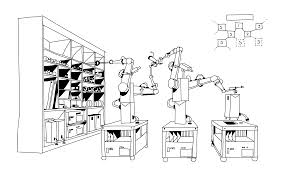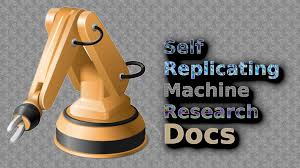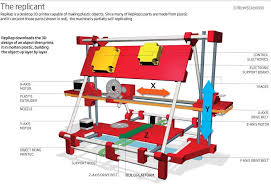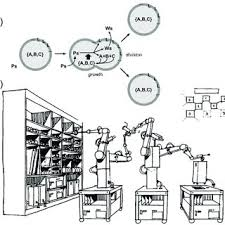Introduction

Self-replicating machines are a revolutionary concept in technology and engineering. They are machines designed with the ability to replicate themselves autonomously, assembling their components from raw materials or resources available in their environment. Inspired by biological systems, where living organisms reproduce by making copies of themselves, self-replicating machines are seen as a potential game-changer across various fields, from manufacturing to space exploration. This technology could drastically reduce the need for human intervention, lower production costs, and offer sustainable solutions for many challenges.
How They Work:

The basic idea behind self-replicating machines is that they can assemble the necessary components to create a replica of themselves. These machines typically follow a few key steps:
Blueprints and Instructions: The machine has a set of blueprints or programming that tells it how to assemble its components, which can range from simple parts like screws and gears to complex materials.
Component Acquisition: The machine must gather raw materials from its environment—this could include metal, plastic, or any material the machine is designed to process. In advanced versions, the machine may even be able to mine or harvest these materials autonomously.
Assembly Process: Once the components are gathered, the machine uses advanced manufacturing techniques (such as 3D printing, robotics, or nanotechnology) to build the parts needed for replication.
Replication: The self-replicating machine assembles its components in the correct configuration to create a fully functional copy of itself. This newly created machine can then continue the process and produce more copies.
In theory, once the process begins, the machines can replicate indefinitely, provided there are enough raw materials available. This could potentially lead to an exponential increase in production without much human intervention
What Are the Uses:
Self-replicating machines could have a wide array of uses, particularly in fields where automation, scalability, and resource efficiency are crucial:
Space Exploration: One of the most exciting uses for self-replicating machines is in space. These machines could be sent to other planets or moons to explore, mine resources, or even build infrastructure like habitats or energy sources without the need for humans to be physically present.
Manufacturing and Industry: In manufacturing, self-replicating machines could be used to automate production processes, making factories more efficient. Machines could replicate and assemble themselves or other products in remote locations, helping businesses scale up production at a much lower cost.
Disaster Relief and Remote Locations: Self-replicating machines could be deployed in areas where human presence is dangerous or impractical, such as disaster zones, deep ocean environments, or remote wilderness areas. They could be used to build shelters, generate energy, or even produce medical supplies.
Environmental Restoration: Self-replicating machines could help with environmental cleanup and restoration efforts, such as filtering out pollution or planting trees in deforested regions. They could be programmed to harvest resources sustainably and repair ecosystems.
Sustainable Agriculture: These machines could be used to autonomously plant crops, monitor soil health, or harvest crops, all while minimizing waste and optimizing resources. Their self-replicating nature could lead to more sustainable and scalable agricultural practices.
Medical Applications: In medicine, self-replicating machines could potentially be used for drug production, medical diagnostics, or even delivering treatments inside the human body. Microscopic machines could be designed to replicate and repair cells or tissues at a molecular level.
Advantages:

Self-replicating machines offer numerous advantages, particularly in automation, efficiency, and sustainability:
Cost-Effective Production: Once the initial self-replicating machine is developed, it can produce more machines at a low cost. This could lead to large-scale manufacturing with reduced labor and material costs.
Scalability: The ability for machines to replicate themselves could allow for rapid scaling of production without a proportional increase in human labor or resources.
Reduced Human Labor: Self-replicating machines can work autonomously, reducing the need for human workers in dangerous or repetitive tasks. This could improve safety and free up human workers for more complex or creative tasks.
Resource Efficiency: These machines could be designed to efficiently use raw materials, reducing waste. In some cases, they might even be able to process and recycle discarded materials into new machines.
Increased Availability in Remote Areas: Self-replicating machines could be deployed in locations that are difficult or dangerous for humans to reach, such as the deep ocean, outer space, or areas affected by natural disasters.
Sustainability: With the ability to replicate themselves from sustainable resources, self-replicating machines could contribute to a circular economy, reducing the need for extraction and resource depletion.
Disadvantages:

While self-replicating machines present many exciting possibilities, there are several drawbacks and risks to consider:
- Ethical Concerns: The idea of machines replicating themselves without human oversight raises ethical questions. There is a risk that they could be used for harmful purposes, like creating uncontrollable, destructive machines or proliferating in ways that could cause environmental damage.
- Resource Overuse:High Initial Development Costs: Designing and building the first self-replicating machines could require significant research, development, and funding. Until the technology matures, the costs might outweigh the benefits. If not carefully controlled, self-replicating machines could consume resources at an unsustainable rate. They may deplete materials faster than the environment can provide them, leading to potential ecological imbalances.
- Security Risks: Autonomous machines could be hacked or repurposed for malicious intent, leading to security concerns. A self-replicating machine that can be remotely controlled might be used as a weapon or cause widespread disruptions.
Future Scope:
The potential for self-replicating machines is vast, but significant challenges must be addressed before they can become mainstream. However, their future scope is extremely promising, especially in areas that require rapid and scalable solutions:
Space Exploration: Self-replicating machines could be a game-changer for interplanetary exploration. They could be deployed to build habitats, mine asteroids, or extract resources from other planets without human involvement, allowing for a permanent human presence in space.
Advanced Manufacturing: As technology advances, self-replicating machines could become a cornerstone of the manufacturing industry. Fully automated factories could operate with minimal human supervision, producing everything from electronics to medical equipment with precision and speed.
Environmental Sustainability: These machines could be used to address pressing environmental issues, such as pollution or resource depletion. They could create new systems for waste management, recycling, and sustainable agriculture, helping to mitigate human impact on the planet.
Nanotechnology and Medicine: On a microscopic scale, self-replicating nanomachines could revolutionize medicine, potentially repairing damaged tissues, delivering drugs, or even reversing aging processes. This would lead to breakthroughs in personalized medicine and human health.
Global Infrastructure: Self-replicating machines could help build and maintain infrastructure in developing regions or areas affected by natural disasters. They could also assist in providing essential services such as water purification, electricity generation, or communication networks in remote locations.
In conclusion, while self-replicating machines are still in the conceptual phase, they have the potential to revolutionize industries, from manufacturing to space exploration. Their ability to replicate autonomously could drastically reduce costs, improve efficiency, and solve some of the world’s most pressing problems. However, careful consideration must be given to the ethical, environmental, and security risks associated with this technology. As research progresses, we may see self-replicating machines become an integral part of our technological landscape, ushering in a new era of automation and innovation.
